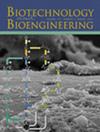Cost-Efficient Autotrophic High-Cell-Density Cultivation of Cupriavidus necator Enabled by Model-Based Gas Supply.
IF 3.6
2区 生物学
Q2 BIOTECHNOLOGY & APPLIED MICROBIOLOGY
引用次数: 0
Abstract
Cultivating hydrogen-oxidizing bacteria (HOB), such as Cupriavidus necator, using H 2 ${{\rm{H}}}_{2}$ , CO 2 ${\text{CO}}_{2}$ , and O 2 ${{\rm{O}}}_{2}$ offers a promising route for CO 2 ${\text{CO}}_{2}$ valorization into chemicals and materials. To enhance cultivation efficiency in a lab-scale gas fermenter lacking a gas recycling system, an automated gas supply strategy based on real-time CO 2 ${\text{CO}}_{2}$ and O 2 ${{\rm{O}}}_{2}$ monitoring was developed. Fine-tuning gas delivery is essential to ensure an adequate supply for cellular growth while minimizing excess gas, particularly H 2 ${{\rm{H}}}_{2}$ , that leaves the bioreactor unused, to improve process economics. In the absence of ATEX-compliant H 2 ${{\rm{H}}}_{2}$ sensors, a soft sensor was implemented to estimate dissolved H 2 ${{\rm{H}}}_{2}$ concentrations from O 2 ${{\rm{O}}}_{2}$ uptake rates and growth phase identification. Total gas flow was controlled according to the O 2 ${{\rm{O}}}_{2}$ requirements of the cells. This strategy reduced overall gas and H 2 ${{\rm{H}}}_{2}$ consumption by 67%. In addition, a high-cell-density medium was formulated by integrating published recipes with Inductively Coupled Plasma Optical Emission Spectroscopy and nutrient inhibition testing. The optimized medium increased biomass yield from 15 g/L to 53 g/L, with 75% of the dry weight consisting of the bioplastic poly(3-hydroxybutyrate), without requiring nutrient addition or pH control. Together, these strategies improve the scalability, efficiency, and sustainability of CO 2 ${\text{CO}}_{2}$ -based cultivation of hydrogen-oxidizing bacteria.基于模型的供气系统支持的高效自养高细胞密度培养赤铜鱼。
利用h2 ${\ rm{H}}}_{2}$、CO 2 ${\text{CO}}_{2}$和o2 ${\ rm{O}}}_{2}$培养氧化氢细菌(HOB),如Cupriavidus necator,为CO 2 ${\text{CO}}_{2}$转化为化学品和材料提供了一条有前途的途径。为了提高实验室规模无气体回收系统的发酵罐的培养效率,开发了一种基于co2 ${\text{CO}}_{2}$和o2 ${{\rm{O}}}_{2}$实时监测的自动化供气策略。微调气体输送是必不可少的,以确保足够的细胞生长供应,同时尽量减少多余的气体,特别是h2 ${{\rm{H}}}_{2}$,使生物反应器闲置,以提高过程经济性。在缺乏符合atex标准的h2 ${{\rm{H}}}_{2}$传感器的情况下,采用软传感器从o2 ${{\rm{O}}}_{2}$摄取速率和生长阶段鉴定中估计溶解的h2 ${{\rm{H}}}_{2}$浓度。总气流量按细胞的O 2 ${{\rm{O}}}_{2}$要求控制。该策略将总天然气和h2 ${{\rm{H}}}_{2}$消耗降低了67%。此外,将已发表的配方与电感耦合等离子体发射光谱和营养抑制测试相结合,配制了一种高密度培养基。优化后的培养基将生物质产量从15 g/L提高到53 g/L,其中75%的干重由生物塑料聚(3-羟基丁酸酯)组成,无需添加营养物质或控制pH。总之,这些策略提高了基于co2的氧化氢细菌培养的可扩展性、效率和可持续性。
本文章由计算机程序翻译,如有差异,请以英文原文为准。
求助全文
约1分钟内获得全文
求助全文
来源期刊

Biotechnology and Bioengineering
工程技术-生物工程与应用微生物
CiteScore
7.90
自引率
5.30%
发文量
280
审稿时长
2.1 months
期刊介绍:
Biotechnology & Bioengineering publishes Perspectives, Articles, Reviews, Mini-Reviews, and Communications to the Editor that embrace all aspects of biotechnology. These include:
-Enzyme systems and their applications, including enzyme reactors, purification, and applied aspects of protein engineering
-Animal-cell biotechnology, including media development
-Applied aspects of cellular physiology, metabolism, and energetics
-Biocatalysis and applied enzymology, including enzyme reactors, protein engineering, and nanobiotechnology
-Biothermodynamics
-Biofuels, including biomass and renewable resource engineering
-Biomaterials, including delivery systems and materials for tissue engineering
-Bioprocess engineering, including kinetics and modeling of biological systems, transport phenomena in bioreactors, bioreactor design, monitoring, and control
-Biosensors and instrumentation
-Computational and systems biology, including bioinformatics and genomic/proteomic studies
-Environmental biotechnology, including biofilms, algal systems, and bioremediation
-Metabolic and cellular engineering
-Plant-cell biotechnology
-Spectroscopic and other analytical techniques for biotechnological applications
-Synthetic biology
-Tissue engineering, stem-cell bioengineering, regenerative medicine, gene therapy and delivery systems
The editors will consider papers for publication based on novelty, their immediate or future impact on biotechnological processes, and their contribution to the advancement of biochemical engineering science. Submission of papers dealing with routine aspects of bioprocessing, description of established equipment, and routine applications of established methodologies (e.g., control strategies, modeling, experimental methods) is discouraged. Theoretical papers will be judged based on the novelty of the approach and their potential impact, or on their novel capability to predict and elucidate experimental observations.
 求助内容:
求助内容: 应助结果提醒方式:
应助结果提醒方式:


